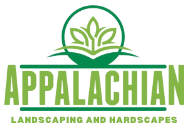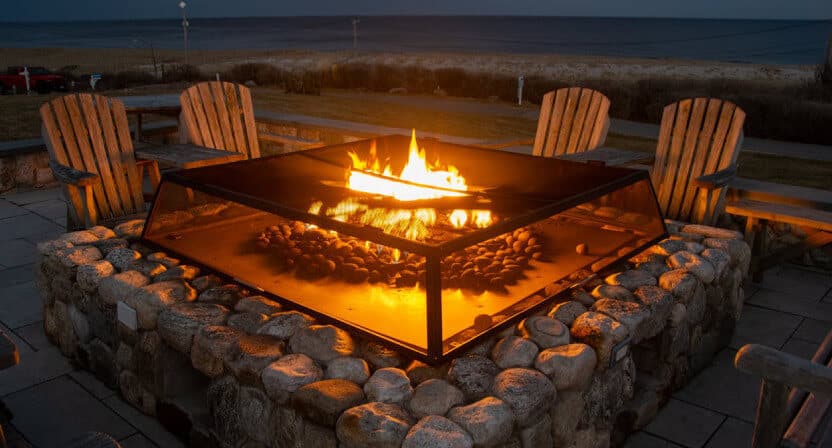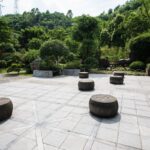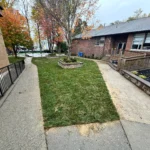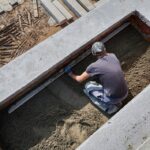A custom masonry fire pit can transform any outdoor living space into a captivating gathering spot. This guide walks readers through every stage of the project—from planning and material selection to construction techniques and finishing touches.
It is designed to help homeowners and outdoor enthusiasts create an inviting focal point that enhances both beauty and functionality. With a friendly, third-person tone and actionable advice, this article also highlights how professional services from Appalachian Scapes TN can elevate the project, ensuring a seamless blend of creativity and expert craftsmanship.
Understanding the Basics of Masonry Fire Pit Design
Masonry fire pits are celebrated for their durability, timeless aesthetic, and versatility. By using high-quality materials such as natural stone or brick, a masonry fire pit not only serves as a source of warmth but also acts as a centerpiece for outdoor gatherings. The combination of heat and natural materials creates an inviting atmosphere that encourages conversation and relaxation. Professionals in the industry stress that a well-designed fire pit should balance both functionality and beauty while complementing the overall outdoor environment.
Key Benefits of a Custom Masonry Fire Pit
- Longevity: Constructed with robust materials, these fire pits stand up to weather and time.
- Aesthetic Appeal: The natural look of stone or brick adds a unique charm to any yard.
- Versatility: They can be integrated into various outdoor design themes—from rustic retreats to modern landscapes.
- Value Addition: A custom fire pit enhances property value and outdoor living experiences.
Planning and Preparation for Your Fire Pit Project
Before breaking ground, thorough planning is essential. Homeowners should evaluate their space, check local building codes, and consider environmental factors such as wind patterns and drainage. Budgeting and designing the layout are crucial steps that set the foundation for a successful project.
Brainstorming Design Concepts
When exploring outdoor fire pit ideas, it is important to look at a variety of styles and configurations. Inspirational images and mood boards can help in visualizing the project, ensuring that the fire pit will integrate well with the existing landscape. Design considerations include:
- Location: A safe distance from structures and trees.
- Size and Shape: Proportional to the available space.
- Safety: Adequate clearance and a stable structure.
- Functionality: Accommodating seating and additional features like cooking areas.
Creating a Detailed Plan
A detailed plan includes sketches or blueprints that outline dimensions, material quantities, and the construction sequence. Homeowners might work with a landscape architect or consult professionals from companies like Appalachian Scapes TN, who can offer expert advice tailored to the unique aspects of the space.
Material Selection: Stone, Brick, and Beyond
The materials chosen for a masonry fire pit play a significant role in its durability and visual appeal. Homeowners have several options, each with distinct benefits.
Choosing the Right Materials
- Natural Stone: Offers a rugged, timeless look that can blend into various landscapes.
- Bricks: Provide uniformity and can be arranged in intricate patterns.
- Concrete Blocks: Serve as a budget-friendly alternative with modern appeal.
For enthusiasts who appreciate a hands-on approach, a DIY stone fire pit can offer both a creative challenge and a sense of personal achievement. Carefully sourced stones that match the local aesthetic and environment contribute to the overall success of the project.
Considerations When Sourcing Materials
- Quality: Durable materials that withstand weather extremes.
- Availability: Locally sourced materials can reduce costs and environmental impact.
- Cost: Budget constraints should be balanced with long-term durability and appearance.
A well-chosen palette of materials can enhance the fire pit’s resilience while reflecting the homeowner’s personal style.
Designing Your Layout for Aesthetic Appeal and Functionality
The layout of a fire pit is as important as the materials used. A thoughtfully designed structure ensures not only visual harmony but also practical functionality.
Steps for Effective Layout Design
- Assess the Space: Measure the area and consider traffic flow and safety.
- Create a Focal Point: The fire pit should naturally draw attention.
- Plan for Seating: Ensure there is ample space for comfortable seating without compromising the fire pit’s safety zone.
- Integrate with Landscape: The design should harmonize with existing garden features and hardscape elements.
A well-planned layout reflects a backyard fire pit design that considers both style and functionality, turning an ordinary space into an inviting haven for social gatherings.
Masonry Fire Pit Construction Techniques and Tips
Solid construction is paramount in building a safe and long-lasting fire pit. Precision in masonry work ensures the structure can contain high temperatures and resist the elements.
Essential Construction Techniques
- Foundation: A level and stable base is crucial. Typically, a gravel or sand base is recommended to ensure drainage and stability.
- Laying the Stones or Bricks: Each layer should be carefully aligned and securely mortared. Proper spacing allows for expansion and contraction due to heat.
- Curing Time: Allowing adequate time for the mortar to set ensures structural integrity.
- Finishing Touches: Sealing the fire pit can prevent water infiltration and prolong its lifespan.
These guidelines form the core of masonry fire pit construction, emphasizing safety and durability throughout the building process.
Creating Effective Brick Fire Pit Plans
Blueprints and plans are indispensable in transforming a concept into a tangible structure. Detailed plans help in visualizing the final product and serve as a roadmap during construction.
Components of a Successful Blueprint
- Dimensions: Clearly defined measurements for the fire pit’s diameter and height.
- Material List: An itemized list of bricks, mortar, and other necessary supplies.
- Construction Sequence: A step-by-step guide from the foundation to the final layer.
- Safety Features: Design elements that ensure safe usage, including proper clearances and ventilation.
By incorporating brick fire pit plans that detail each phase of construction, homeowners can approach the project with confidence and precision.
Executing a Custom Fire Pit Installation
Executing a Custom Fire Pit Installation
Once planning and design are complete, it’s time to bring the vision to life with a structured installation process. This phase combines meticulous preparation with expert craftsmanship.
Installation Process Overview
- Site Preparation: Clearing and leveling the designated area.
- Laying the Foundation: Establishing a robust base that can support the fire pit.
- Building the Structure: Carefully placing and mortaring each brick or stone.
- Inspection and Adjustments: Regularly checking alignment and stability throughout the construction.
This step-by-step approach forms the basis of a custom fire pit installation that results in a safe, visually appealing, and durable outdoor feature.
Enhancing Your Fire Pit with a Thoughtful Seating Area
A well-designed fire pit is incomplete without comfortable seating. A thoughtfully arranged seating space enhances the overall experience, making the area inviting for relaxation and socialization.
Designing the Perfect Seating Arrangement
- Comfort: Use weather-resistant furniture and soft cushions.
- Layout: Arrange seating to maximize views of the fire pit while ensuring easy movement.
- Accessibility: Ensure that seating areas are close enough to the fire pit for warmth but safely distanced to avoid accidents.
- Style: Choose designs that complement the natural aesthetics of the fire pit and the surrounding landscape.
Creating a designated fire pit seating area provides a cozy spot where friends and family can gather and enjoy evenings by the fire.
Final Touches: Finishing Your Custom Masonry Fire Pit
After the core construction is complete, the finishing touches can elevate the project from functional to extraordinary. Landscaping, lighting, and additional features can enhance the ambiance and usability of the fire pit.
Adding the Finishing Details
- Landscaping: Integrate native plants and decorative stonework around the fire pit to create a harmonious outdoor environment.
- Lighting: Use subtle, warm lighting to accentuate the fire pit during evening hours.
- Maintenance: Regular cleaning and occasional resealing of the masonry will preserve the fire pit’s appearance and performance.
- Accessories: Consider adding side tables, storage for firewood, and even a grill for versatile outdoor cooking.
These enhancements ensure that the fire pit remains the centerpiece of the outdoor space, providing both visual appeal and practical benefits.
Why Choose Appalachian Scapes TN?
For homeowners seeking professional assistance, Appalachian Scapes TN offers a wealth of expertise in outdoor design and construction. With years of experience in creating custom outdoor living spaces, the team ensures that every project meets high standards of quality and aesthetic appeal. Their comprehensive services cover every aspect of the design and construction process, from initial consultation to the final installation.
What Sets Them Apart?
- Expertise: A deep understanding of masonry techniques and landscape integration.
- Customization: Tailored solutions that reflect each client’s unique style and needs.
- Quality Assurance: Use of premium materials and adherence to industry standards.
- Customer Satisfaction: A commitment to creating outdoor spaces that enhance lifestyle and property value.
By choosing professional services, homeowners can ensure a stress-free process that results in a stunning, functional fire pit that stands the test of time.
Summary Table: Key Elements of a Custom Masonry Fire Pit Project
| Stage | Key Considerations | Action Steps |
|---|---|---|
| Planning & Preparation | Space assessment, design inspiration, budgeting | Create a detailed plan with sketches and material lists |
| Material Selection | Durability, quality, local availability | Choose between stone, brick, and other options |
| Layout Design | Proportional size, safety zones, seating arrangement | Map out the fire pit’s dimensions and surroundings |
| Construction Techniques | Foundation, alignment, mortar setting | Follow precise masonry methods and safety protocols |
| Blueprint & Planning | Detailed drawings, step-by-step guide | Develop comprehensive plans and verify measurements |
| Installation Process | Site preparation, careful assembly, regular inspections | Execute the build with periodic quality checks |
| Finishing Touches | Landscaping, lighting, maintenance | Add aesthetic and functional elements post-installation |
Bringing It All Together
Designing a custom masonry fire pit requires careful planning, quality materials, and expert execution. Each stage—from brainstorming design concepts to the final installation and finishing touches—is integral to creating a safe, durable, and visually appealing outdoor centerpiece. By considering every element discussed in this guide, homeowners can achieve a project that is both functional and a testament to personal style.
For those looking for professional guidance or who prefer a hassle-free experience, partnering with experts like Appalachian Scapes TN can make all the difference. Their experience in outdoor transformations ensures that every project is executed with precision and creativity, resulting in a stunning fire pit that enhances both the beauty and value of a property.
Final Thoughts
Creating a custom masonry fire pit is more than just a construction project—it is an investment in an enhanced outdoor lifestyle. With thoughtful design, careful material selection, and adherence to expert construction techniques, the fire pit becomes a space where lasting memories are made. Whether planning the layout yourself or seeking professional assistance, every step of the process contributes to a warm, inviting ambiance that draws family and friends together.
This comprehensive guide has provided actionable insights and practical tips, ensuring that every aspect of the project is well considered. If any part of the guide requires further expansion or clarification, such as detailed installation tutorials or advanced design customization tips, the topic can be revisited in future articles or through consultation with experts in the field.
